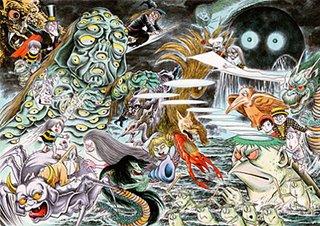
• In ancient Japan it was believed that life dwelled in all things and that everything in nature was of divine origin. It was strongly accepted among the Japanese that creatures with supernatural powers coexisted with humans. Most of us in the West are familiar with the giant monsters, daikaijuu, from the Godzilla movies; but there are hundreds of traditional yokai in Japanese folklore. Yokai, monstrous spirits, is a general category to fit all of the various forms of these creatures into.
The influence of the Shinto religion may be one reason for so many supernatural spirits in Japanese culture. Shinto is an ancient animistic religion; and it is easier to accept a sprit's existence if a more human form is given to it. Yokai come in many styles and shapes, from the comical looking umbrella ghost, kasa obake, to a more malicious creature like a kappa, the only thing these river spirits like to eat better than children are cucumbers. There is a wall that appears unexpectedly present a barrier, a flying piece of white cloth, ittan momen, and many many more.
During Japan’s Edo Period, 1603-1867, the belief in yokai was at its peak; but as the the Maji Period, 1867-1912, progressed, the increase in scientific thinking decreased the belief in the supernatural. The cartoonist Shigeru Mizuki created a manga, Gegege no Kitaro, in the 1960’s about a boy who had been born in a cemetery and was part demon. Kitaro worked to smooth out the coexistence between yokai and humans. These popular comic books, and later anime , reintroduced and popularized the traditional monsters.

No comments:
Post a Comment